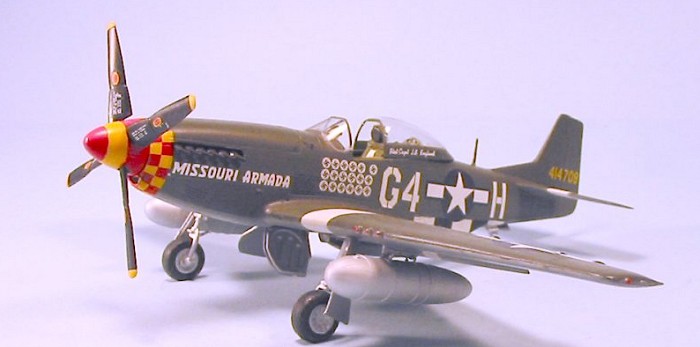
| KIT: | ICM 1/48 P-51D Mustang |
| KIT #: | ? |
| PRICE: | $10.00 MSRP |
| DECALS: | See Review |
| REVIEWER: | Tom Cleaver |
| NOTES: |

| HISTORY |
The 357th Fighter Group was the first unit originally equipped with the P-51 Mustang to serve in the Eighth Air Force. Following the decision to assign the 9th Air Force’s 354th Fighter Group to operational control of the Eighth as a long-range escort group, Eighth Air Force command moved heaven and earth to get the nest P-51 units destined for the Ninth reassigned to the Eighth. They swapped the new P-47-equipped 358th Fighter Group for the P-51-equipped 357th after convincing the Ninth that P-47s were better suited for the ground attack role that air force would be assigned to for the invasion - which was in fact true, as history proves.
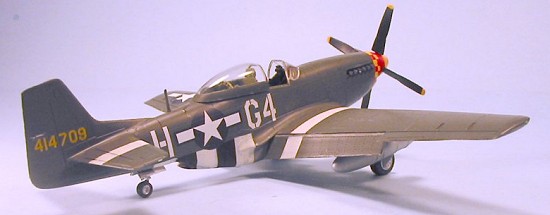 The 357th had been formed on December 16, 1942 at Hamilton
Field, north of San Francisco, and had spent some eight months training its
newly-minted pilots with the P-39, first at Hamilton and later at Tonopah,
Utah, where flight restrictions were fewer since there were less people to
possibly complain about any “flat-hatting,” though 14 pilots were killed in
accidents during this time. The unit was ready for transfer to England in
October 1943.
The 357th had been formed on December 16, 1942 at Hamilton
Field, north of San Francisco, and had spent some eight months training its
newly-minted pilots with the P-39, first at Hamilton and later at Tonopah,
Utah, where flight restrictions were fewer since there were less people to
possibly complain about any “flat-hatting,” though 14 pilots were killed in
accidents during this time. The unit was ready for transfer to England in
October 1943.
The 357th entered combat on February 11, 1944, at the opening of what was known as “Big Week,” an offensive directed against the Luftwaffe and the factories supporting it, which actually lasted throughout February with missions being flown every day the weather allowed. It was the “opening bell” of The Battle of Germany, the effort to defeat the Luftwaffe and gain air superiority over Western Europe by the summer, when the invasion was set.
The P-51Bs of the 357th were the first allied fighters over
Berlin on March 4, 1944 , along with the 336th Squadron of the e
4th Fighter Group. Flying Mustangs throughout the campaign
insured the unit would be assigned the hottest part of the missions -
target escort - where they were almost certain to always meet the
Luftwaffe. Throughout March and April the battle raged, with the Luftwaffe
finally unable to meet a major attack in mid-April. During the Spring of
1944, the Luftwaffe lost 70 percent of their squadron and flight leaders,
as well as several of their group and wing commanders, in addition to other
veteran pilots. It was a loss the Luftwaffe could ill afford and would
never be able to replace. By late April, American fighters were strafing
German airdromes on the way back from their escort missions, due to the
fact the Luftwaffe wasn’t coming up to fight. By that May, the Luftwaffe
had been effectively beaten. That air superiority had been achieved was
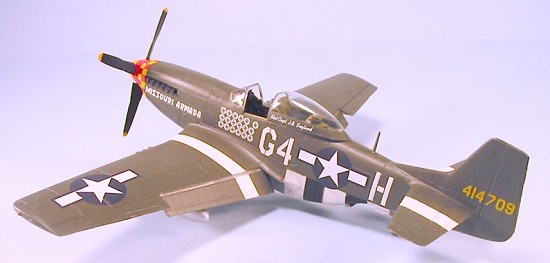 demonstrated by the fact that only two Luftwaffe fighters showed up over
the invasion beaches on June 6. Throughout the summer of 1944, the
fighters of the Eighth, along with those of the Ninth that were more and
more based in France, took on the Luftwaffe over the battlefield of
northwestern France. By the end of August, with Paris liberated, the
Luftwaffe was a shadow of its former self and could never mount more than
token resistance throughout the rest of the war. The untested kids of units
like the 357th had smashed what had been consideredd the world’s
leading air force.
demonstrated by the fact that only two Luftwaffe fighters showed up over
the invasion beaches on June 6. Throughout the summer of 1944, the
fighters of the Eighth, along with those of the Ninth that were more and
more based in France, took on the Luftwaffe over the battlefield of
northwestern France. By the end of August, with Paris liberated, the
Luftwaffe was a shadow of its former self and could never mount more than
token resistance throughout the rest of the war. The untested kids of units
like the 357th had smashed what had been consideredd the world’s
leading air force.
In August, the 357th escorted B-17s to Russia, Italy and back home on one of the shuttle missions. During Operation Market Garden - the airborne landing in northern Holland in September - the 357th destroyed 50 enemy aircraft in two days. On January 14, 1945, the group fought its biggest battle and experienced its greatest success when the three squadrons shot down 55.5 German fighters over Berlin, in what would be the last major combat of that size of the war.
By V-E Day, the 357th Fighter Group had produced the highest number of aces in the Eighth Air Force - (43), five of whom scored more than 15victories and four of whom scored more than 10. This widespread “acedom” was a credit to leadership throughout the group. The 357th scored 695 air victories, making them second to the 56th Fighter Group, which was in combat a year longer.
LCOL John B. England:
John B. England, born January 15, 1923, in Caruthersville, Missouri, enlisted in the Army as a Private in April 1942. After graduating from flight school, he was commissioned a 2nd Lt. and assigned to the 357th Fighter Group in November 1943. He would fly a total of 108 combat missions for a double tour of 460 combat hours. He eventually became the group’s leading ace with 17.5 aerial and 1.5 ground victories.
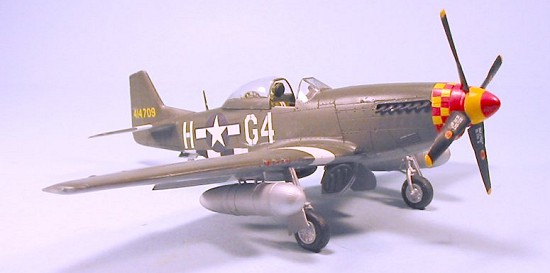 On one mission, he destroyed four enemy planes and was awarded the Silver
Star. He said he owed part of his success to the K-14 “no missum”
gyroscopic gunsight and the G-suit. By September 13, 1944 he was CO of the
362nd Fighter Squadron. Leading the unit over Germany at 8000 ft., he
spotted a Bf-109 diving away. Seeing it was headed for an airfield England
pushed his P-51 to 400 mph at 3,000 feet (quite an accomplishment). Closing
to 500 yards and with the K-14 locked on, he fired and saw the strikes on
the Bf-109's engine and cockpit before it crashed. He shot down two more
Bf-109s on that mission.
On one mission, he destroyed four enemy planes and was awarded the Silver
Star. He said he owed part of his success to the K-14 “no missum”
gyroscopic gunsight and the G-suit. By September 13, 1944 he was CO of the
362nd Fighter Squadron. Leading the unit over Germany at 8000 ft., he
spotted a Bf-109 diving away. Seeing it was headed for an airfield England
pushed his P-51 to 400 mph at 3,000 feet (quite an accomplishment). Closing
to 500 yards and with the K-14 locked on, he fired and saw the strikes on
the Bf-109's engine and cockpit before it crashed. He shot down two more
Bf-109s on that mission.
LCOL England returned to the United States in February 1945. He remained in the Air Force after the war. Returning to Toul Air Force Base in France from a training flight in his F-86 "Sabre" on November 21, 1954, Colonel England experienced a flameout in the pattern. Faced with a choice of attempting to glide over the barracks his men lived in to make a landing, or turning aside to avoid a likely crash into the barracks, he choose the latter and was killed in the explosion following the crash. Alexandria Air Force Base in Louisiana was renamed England Air Force Base June 23, 1955 in his honor.
| THE KIT |
The ICM P-51D, a well-known copy of the Tamiya P-51D combines most of the good design and production quality of that kit, with a price less than half the original. (After a rather rocky year or so ICM has been purchased and is now back in business. I hope this lasts a while as they do offer a good deal for the money. Here is a URL that may be of interest. Ed. http://www.icm.com.ua/eng/index_en.html )
| RENOVATION |
I have a policy that, when I have a well-built model, if it turns out that time has not been kind to the finish, or if better alternatives to markings come along, then that model is a prime candidate to head for the paint stripper shop, then to the paint shop for a new scheme. Given the price of models nowadays, and the fact that it’s virtually impossible not to assemble a great model from either the Tamiya or ICM P-51 kits, this policy makes good economic sense to me.
There are three ways to strip paint off a model. If you are one of
those who thinks using oven cleaner is a viable option, perhaps you will
want to re ad another
article.
ad another
article.
There are two good strippers available. Polly S “ELO” (Easy Lift Off) and Strip-A-Kit. If you use ELO, you have to be careful it doesn’t eat the model; don’t put it on for more than 10 minutes at a time, or you will find the plastic joints coming apart in strange (and not nice) ways. You can completely ruin a canopy by dipping it in ELO; other canopies will be fine - and the only way you will learn which is which is to “just do it.” I have used ELO many times, and likely will again. That said....
Strip-A-Kit (no longer produced) may not work as quickly as ELO, and may require more applications to get down to bare plastic. But you will never ever have the model come apart at the joints, and there is no clear plastic that will craze if SAK is applied to it. SAK will not disassemble your model, as oven cleaner will do. In other words, your model is safe. Need I say more as to which is the best to use?
After about 4 different applications of SK (break through the varnish, hit the big areas, take off the paint below the decals, get rid of the paint in the difficult areas), the model was down to some left-over SnJ that wasn’t going to come off without more work than was needed, since painting over the SnJ was easy to do.
| COLORS & MARKINGS |
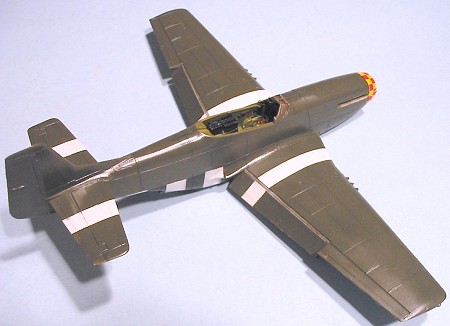 By May 1944, most fighter groups in England were flying all-silver
airplanes. Eighth Air Force HQ advised the groups to camouflage the upper
surfaces of their aircraft, in anticipation of operating from forward air
fields in France where they would be subject to attack on the ground. The
357th FG followed this order more completely than any other
unit, completely painting their aircraft in camouflage. There has long
been discussion of just which colors they used, but the common wisdom now
is that they were painted with RAF Dark Green upper surfaces and Ocean Grey
lower surfaces, since these were the colors most available that were
closest to Army Olive Drab Shade 41 and Neutral Grey.
By May 1944, most fighter groups in England were flying all-silver
airplanes. Eighth Air Force HQ advised the groups to camouflage the upper
surfaces of their aircraft, in anticipation of operating from forward air
fields in France where they would be subject to attack on the ground. The
357th FG followed this order more completely than any other
unit, completely painting their aircraft in camouflage. There has long
been discussion of just which colors they used, but the common wisdom now
is that they were painted with RAF Dark Green upper surfaces and Ocean Grey
lower surfaces, since these were the colors most available that were
closest to Army Olive Drab Shade 41 and Neutral Grey.
After pre-shading the model, I painted the D-Day stripes on the lower rear fuselage, and the white Mustang ID stripes on the wing and horizontal stabilizer. By the fall of 1944, this was the way 357th Mustangs looked, as the original overall D-Day stripes had been progressively removed over the summer. Over the course of the fall, many of the Mustangs - such as those flown by Bud Anderson and Chuck Yeager - had their camouflage paint stripped, but it appears most of the original 362nd FS P-51s retained that paint until the airplane was replaced by a new one.
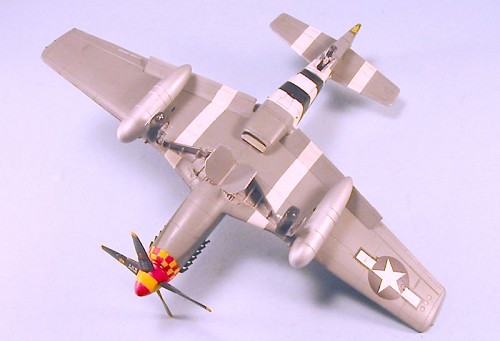 After masking off these areas, I painted the nose and spinner yellow and
masked that off, then applied the lower camouflage color using Gunze-Sangyo
H-337 “Blueish Grey,” a good match to Ocean Grey, and the upper surfaces in
Gunze H-70 “Dark Green,” which is RAF Dark Green. After I unmasked the
model, I gave it a coat of Future.
After masking off these areas, I painted the nose and spinner yellow and
masked that off, then applied the lower camouflage color using Gunze-Sangyo
H-337 “Blueish Grey,” a good match to Ocean Grey, and the upper surfaces in
Gunze H-70 “Dark Green,” which is RAF Dark Green. After I unmasked the
model, I gave it a coat of Future.
Decals:
I had John England’s on the remains of a SuperScale 357th FG sheet, and used them, along with the national markings from a sheet of national markings printed by SNJ. After these airplanes were painted, the stenciling was mostly not re-applied, so I did not worry about that.
| FINAL BITS |
I used 110-gallon “paper tanks” from a Hasegawa Mustang kit, and a Falcon vacuform P-51D canopy. These and the landing gear were attached, the prop was attached, and the model was completed.
| CONCLUSIONS |
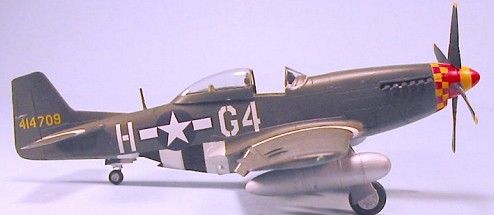 Got the itch to build and don’t know what? Build a Mustang! You could
stick to building no other model and in a lifetime career of
model-building, you could never do all the various markings possibilities
that exist for this beautiful airplane. I like doing the colorful Mustangs
of the Eighth Air Force, and those of the 357th FG are among the
most memorable.
Got the itch to build and don’t know what? Build a Mustang! You could
stick to building no other model and in a lifetime career of
model-building, you could never do all the various markings possibilities
that exist for this beautiful airplane. I like doing the colorful Mustangs
of the Eighth Air Force, and those of the 357th FG are among the
most memorable.
April 2005
Kit courtesy of my wallet.
If you would like your product reviewed fairly and quickly by a site that has nearly 300,000 visitors a month, please contact me or see other details in the Note to Contributors.